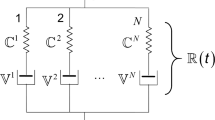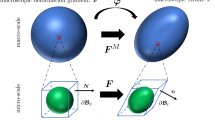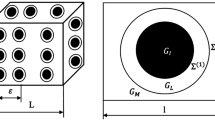Abstract
In this work, a new homogenization method of elasto-viscoplastic composites is developed. Using the fully implicit backward Euler’s integration algorithm, the nonlinear ordinary differential equations in the constitutive laws of the matrix and inclusion phases are discretized. Three classical incremental linearization approaches, i.e., direct, secant and tangent ones are adopted and an affine relationship between the stress and strain increments is deduced. In order to reduce the interaction between the inclusion and matrix phases, a second-ordered map** tensor is introduced and a new map**-tangent linearization approach is proposed. Different linearization approaches are implemented by the incremental self-consistent scheme to predict the overall stress-strain response of particle-reinforced composites. It is shown that the predicted stress-strain curves given by the proposed map**-tangent linearization approach are softer than that by other three classical ones, and are much closer to that from a fullfield finite element simulation. Moreover, the linearized elasto-viscoplastic constitutive equation based on the proposed map**- tangent approach has the same mathematical structure as the rate-independent elasto-plastic constitutive law. In this sense, the homogenization problems faced in the elasto-plastic and elasto-viscoplastic heterogeneous materials can be unified.
Similar content being viewed by others
References
Eshelby J D. The determination of the elastic field of an ellipsoidal inclusion, and related problems. Proc R Soc A-Math Phys Eng Sci, 1957, 241: 376–396
Kröner E. Berechnung der elastischen konstanten des vielkristalls aus den konstanten des einkristalls. Z Physik, 1958, 151: 504–518
Mori T, Tanaka K. Average stress in matrix and average elastic energy of materials with misfitting inclusions. Acta Metall, 1973, 21: 571–574
Hill R. A self-consistent mechanics of composite materials. J Mech Phys Solids, 1965, 13: 213–222
Hill R. Continuum micro-mechanics of elastoplastic polycrystals. J Mech Phys Solids, 1965, 13: 89–101
Hutchinson J W. Bounds and self-consistent estimates for creep of polycrystalline materials. Proc R Soc A-Math Phys Eng Sci, 1976, 348: 101–127
Hutchinson J W. Elastic-plastic behaviour of polycrystalline metals and composites. Proc R Soc A-Math Phys Eng Sci, 1970, 319: 247–272
Molinari A, Canova G R, Ahzi S. A self consistent approach of the large deformation polycrystal viscoplasticity. Acta Metall, 1987, 35: 2983–2994
Doghri I, Ouaar A. Homogenization of two-phase elasto-plastic composite materials and structures. Int J Solids Struct, 2003, 40: 1681–1712
Nemat-Nasser S, Obata M. Rate-dependent, finite elasto-plastic deformation of polycrystals. Proc R Soc A-Math Phys Eng Sci, 1986, 407: 343–375
Peng X, Hu N, Zheng H, et al. Evaluation of mechanical properties of particulate composites with a combined self-consistent and Mori-Tanaka approach. Mech Mater, 2009, 41: 1288–1297
Peng X, Hu N, Long X, et al. Extension of combined self-consistent and Mori-Tanaka approach to evaluation of elastoplastic property of particulate composites. Acta Mech Solid Sin, 2013, 26: 71–82
Masson R, Zaoui A. Self-consistent estimates for the rate-dependent elastoplastic behaviour of polycrystalline materials. J Mech Phys Solids, 1999, 47: 1543–1568
Pierard O, Doghri I. An enhanced affine formulation and the corresponding numerical algorithms for the mean-field homogenization of elasto-viscoplastic composites. Int J Plast, 2006, 22: 131–157
Pierard O, LLorca J, Segurado J, et al. Micromechanics of particlereinforced elasto-viscoplastic composites: Finite element simulations versus affine homogenization. Int J Plast, 2007, 23: 1041–1060
Molinari A, Ahzi S, Kouddane R. On the self-consistent modeling of elastic-plastic behavior of polycrystals. Mech Mater, 1997, 26: 43–62
Mercier S, Molinari A. Homogenization of elastic-viscoplastic heterogeneous materials: Self-consistent and Mori-Tanaka schemes. Int J Plast, 2009, 25: 1024–1048
Wang H, Wu P D, Tomé C N, et al. A finite strain elastic-viscoplastic self-consistent model for polycrystalline materials. J Mech Phys Solids, 2010, 58: 594–612
Mercier S, Molinari A, Berbenni S, et al. Comparison of different homogenization approaches for elastic-viscoplastic materials. Model Simul Mater Sci Eng, 2012, 20: 024004
Wang H, Capolungo L, Clausen B, et al. A crystal plasticity model based on transition state theory. Int J Plast, 2017, 93: 251–268
Turner P A, Tomé C N. Self-consistent modeling of visco-elastic polycrystals: Application to irradiation creep and growth. J Mech Phys Solids, 1993, 41: 1191–1211
Turner P A, Tomé C N, Woo C H. Self-consistent modelling of nonlinear visco-elastic polycrystals: An approximate scheme. Philos Mag A, 1994, 70: 689–711
Doghri I, Adam L, Bilger N. Mean-field homogenization of elastoviscoplastic composites based on a general incrementally affine linearization method. Int J Plast, 2010, 26: 219–238
Miled B, Doghri I, Brassart L, et al. Micromechanical modeling of coupled viscoelastic-viscoplastic composites based on an incrementally affine formulation. Int J Solids Struct, 2013, 50: 1755–1769
Wu L, Adam L, Doghri I, et al. An incremental-secant mean-field homogenization method with second statistical moments for elastovisco- plastic composite materials. Mech Mater, 2017, 114: 180–200
Chaboche J, Kanoute P, Roos A. On the capabilities of mean-field approaches for the description of plasticity in metal matrix composites. Int J Plast, 2005, 21: 1409–1434
Peng X, Tang S, Hu N, et al. Determination of the Eshelby tensor in mean-field schemes for evaluation of mechanical properties of elastoplastic composites. Int J Plast, 2016, 76: 147–165
Author information
Authors and Affiliations
Corresponding author
Rights and permissions
About this article
Cite this article
Yu, C., Kang, G. & Fang, D. Mean-field homogenization of elasto-viscoplastic composites based on a new map**-tangent linearization approach. Sci. China Technol. Sci. 62, 736–746 (2019). https://doi.org/10.1007/s11431-018-9393-4
Received:
Accepted:
Published:
Issue Date:
DOI: https://doi.org/10.1007/s11431-018-9393-4




